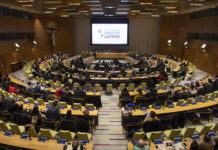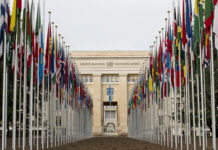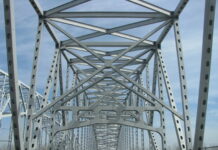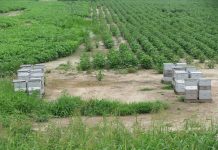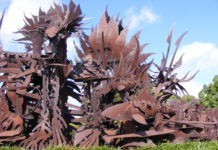Photo credit: DiasporaEngager (www.DiasporaEngager.com).
- Under a 1929 agreement, Egypt refused to acknowledge the rights of the other River Nile riparian countries.
- Almost a century later, Ethiopia is setting up the Grand Ethiopian Renaissance Dam, an initiative that is considered a security threat by Egypt.
- Currently, Ethiopia is undertaking the scheduled filling of the dam from the Nile waters.
River Nile, the longest river in the world continues to be at the center of a long and winding conflict looping together eleven countries that bank on its waters to sustain their economies.
For nearly a century, the Nile waters have remained at the heart of a resource dispute, pitting the countries at the rivers source against those further downstream on its journey to the shores of Egypt. In the latest development, Ethiopian authorities, have announced that the fifth filling of the Grand Ethiopian Renaissance Dam (GERD) is on track for successful completion by December 2024.
While this milestone can be lauded as historic by Ethiopia, it raises concerns and questions among policymakers and citizens across Egypt.
Experts have warned that Ethiopia’s move has the potential to change the Nile system’s hydrological cycle by among others impacting the regular availability of water to millions of people downstream. Another looming impact according to experts is the possibility of changing the water system’s evaporation rates, a shift that could trigger unforeseen environmental fallout.
On its part, however, Ethiopia has refuted claims that it intends to limit its neighbors’ access to water resources. A joint statement issued by Egyptian President Sisi and Ethiopian Prime Minister Abiy Ahmed in July 2023 reaffirmed this position, stating, “Ethiopia made clear its commitment, during the filling of the dam during the hydrological year 2023-2024, not to cause significant harm to Egypt and Sudan in order to provide the water needs of both countries.”
Call for regional cooperation on water use
In the backdrop of these weighty concerns, some experts continue to argue for broad-based regional cooperation initiatives that loop together measures to harness available water resources to guarantee energy generation across the region.
However, the path to such a settlement remains elusive with continued tensions between the main players Ethiopia, Egypt, and Sudan ensure.
For the three countries, the dispute has been simmering for years, leaving experts divided on the best course of action to come out of the challenge. For instance, in a 2023, paper titled “The Nile Dispute: Beyond Water Security“, Ethiopian researcher Gashaw Ayferam, argues, “The Nile dispute has entered a new era of complexity, prompting regional states to compete for water, food, and energy security.”
Gashaw cites the fact that the most recent trigger of the conflict was construction of the Grand Ethiopian Renaissance Dam (GERD) and its ongoing filling by Ethiopia. Until now, Ethiopia and Egypt are locked in a standstill, with authorities in both Addis Ababa and Cairo terming the dam project as “a matter of existential necessity and an existential threat,” respectively.
However, Gashaw is keen to point out that, “this conflict does not revolve only around physical resources but also extends to the very identity of the two states.”
On one hand, the all powerful Egypt that asserts that the GERD construction poses a threat to Egyptian water security and with that, it endangers regional stability. Yet on the other side, Ethiopia (and virtually all the other 10 riparian countries) maintains the GERD is no security risk at all, but rather, it is a necessary development project.
“Despite these different assertions, it is clear that the quests of the conflicting parties to maintain ontological security, or the preservation of state identity, are driving factors for the Nile dispute,” Gashaw comments.
For Egypt, possible security threat in this context arises due to what they describe as “development actions that disrupt the continuity of established identities and worldviews. The GERD project threatens the continuity of Egypt’s enacted world that sees the Nile as a living being inseparable from Egypt’s history, culture, and civilizational identity.”
It is also argued that the ongoing developments on the Nile that are been conducted by Ethiopia (and/or any other riparian state) could potentially force Egypt to redefine its national identity that is historically centered on the Nile River.
River Nile failed dispute resolutions
The first attempt to form a basin-wide organization was made in 1967 by United Nations Development Program (UNDP). This effort, however, did not yield success.
A little over three decades later, the Nile Basin Initiative (NBI) was established in 1999, with a shared vision: “to achieve sustainable socio-economic development through the equitable utilization of, and benefit from, the common Nile basin water resources.”
Two decades into the new millennium, the NBI is no longer touting “water conflict prevention”, but rather it seeks to leans on the push for African integration, largely supporting the call: One River-One People-One Vision.
Noble as it sounds, it seems to acknowledge Ethiopia’s GERD as one of the continent’s energy sector Priority Action Programs and not a single country’s project. This is to say that the hydropower dam in Ethiopia that is to be fed by the Nile waters, is not just a national development project but rather a regional and maybe even a continental master action plan for energy sufficiency.
On the flip side, NBI also recognizes Egypt’s claim of sole-proprietorship of River Nile in that it holds to be the only country with the right to use “significant amounts of the Nile’s waters.”
Read also: Water wars: Ethiopia-Egypt clash as critical GERD talks hit an impasse
River Nile: Benefits of cooperation
The consensus by researchers, policy makers and even politicians is that when it comes to the Nile Basin, “the benefit of cooperation much outweighs the gains from non-cooperation.”
“There are numerous regional benefits garnered from the Nile cooperation,” writes A. Turton and S. McCaffrey in their research note, “Trans-boundary Water Cooperation as a Tool for Conflict Prevention and for Broader Benefit-sharing” that was commissioned by the Ministry for Foreign Affairs, Stockholm, Sweden.
Covering an area of approximately 3.1 million square kilometers, River Nile covers around 10 percent of the African continent and feeds more than three hundred millions of people. As it snakes across the continent, River Nile has two main parts: The Blue Nile originates from Lake Tana, Ethiopia, and the White Nile that starts from Kagera River, in Rwanda.
From these two starting points, the Nile flows through several riparian countries before it finally enters Egypt and pours its waters into the Mediterranean Sea. However, River Nile is not only affected by where it emerges and where it passes, it is also affected by actions of countries that use its waters. The water system feeds into key lakes around its catchment area including Lake Victoria, Africa’s largest lake and from whose waters, the White Nile emerges in Uganda.
Overall, the River Nile is inseparably attached to some eleven riparian countries it serves such as Burundi, Democratic Republic of Congo, Eritrea, Ethiopia, Kenya, Rwanda, Sudan, South Sudan, Tanzania, Uganda.
In his 2005 paper titled, “Cooperation on International Rivers: A Continuum for Securing and Sharing Benefits” scholar David Grey describes the Nile valley as the cradle of civilization, but notes sadly that the area remains under the vice-like grip of food insecurity, desertification, flooding and water scarcity.
“The region has experienced long protracted civil wars in Ethiopia and Sudan, which among others, resulted in the formation of new states in Africa; Eritrea and South Sudan, respectively,” he writes.
“Many gloomy water war predictions mention the Nile River. Even at the time of writing this piece, the Nile waters conflict has re-surfaced dominating both the political and media landscape,” states David Grey, adding, “In spite of its immense potential for irrigation, hydro-electric power production, water supply, fishing, tourism, flood control and navigation, the Nile’s name is now synonymous with water conflict and war”.
Source of original article: Industry and Trade – The Exchange (theexchange.africa).
The content of this article does not necessarily reflect the views or opinion of Global Diaspora News (www.GlobalDiasporaNews.com).
To submit your press release: (https://www.GlobalDiasporaNews.com/pr).
To advertise on Global Diaspora News: (www.GlobalDiasporaNews.com/ads).
Sign up to Global Diaspora News newsletter (https://www.GlobalDiasporaNews.com/newsletter/) to start receiving updates and opportunities directly in your email inbox for free.



